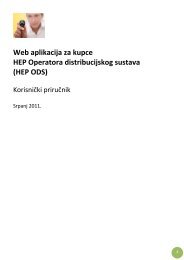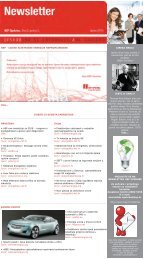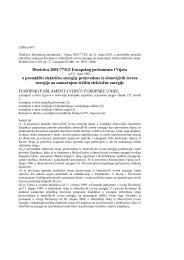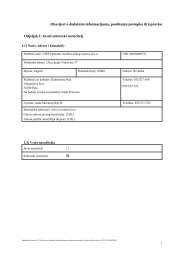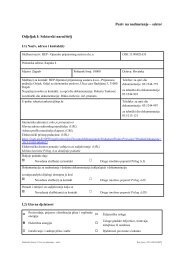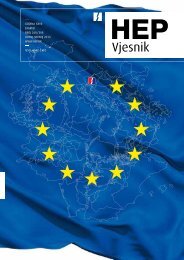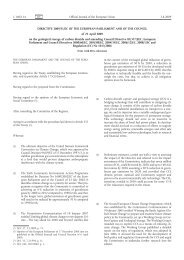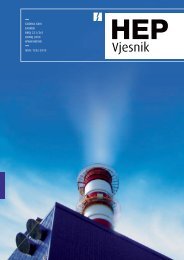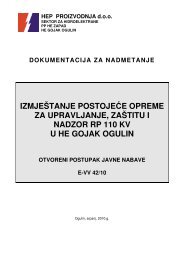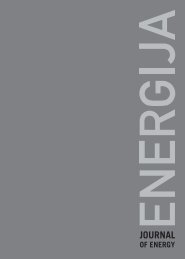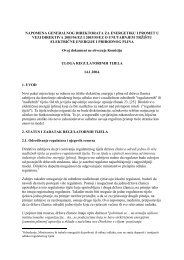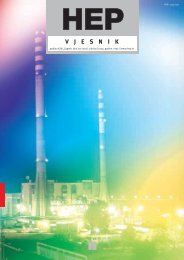3 RESTRUKTURIRANJEELEKTROENERGETSKOGSEKTORA, REGULACIJA ITARIFNI SUSTAVI U REPUBLICIHRVATSKOJU uvodnom dijelu Okruglog stola detaljno jeizloæen kontekst energetskog zakonodavnog okvirai procesa restrukturiranja elektroenergetskog sektora,odnosno otvaranja træiπta elektriËne energijei razvoja i uspostavljanja novog regulatornog okvirau Republici Hrvatskoj [1], [2] i [3]. U tom kontekstui okruæju donesene su i objavljene metodologijetarifnih sustava, a tek treba utvrditi odgovarajuÊestavke za prijenos i distribuciju elektriËne energijete proizvodnju i opskrbu elektriËnom energijom sizuzetkom za povlaπtene kupce.Naime, temeljem vrijedeÊih zakona Hrvatska energetskaregulatorna agencija (u daljnjem tekstu:Agencija) ima obvezu i odgovornost, nakon pribavljenogmiπljenja energetskih subjekata za obavljanjeËijih djelatnosti se primjenjuje tarifni sustavi Ministarstva gospodarstva, rada i poduzetniπtva(u daljnjem tekstu: Ministarstvo), u sektoru elektriËneenergije donijeti metodologije tarifnih sustava,odnosno tarifne sustave bez visine tarifnihstavki, i to za: 1) proizvodnju elektriËne energije,s iznimkom za povlaπtene kupce, 2) opskrbuelektriËnom energijom, s iznimkom povlaπtenihkupaca, 3) prijenos elektriËne energije, 4) distribucijuelektriËne energije, 5) utvrappleivanje naknadeza prikljuËak na prijenosnu i distribucijsku mreæu,te poveÊanje prikljuËne snage, 6) pruæanje uslugauravnoteæenja elektriËne energije u elektroenergetskomsustavu.Prethodno navedene metodologije morajuomoguÊavati ulaganja potrebna za razvoj mreæe iostale zahtjeve sukladno postojeÊim zakonima.Temeljem vrijedeÊih zakona energetski subjekt zaobavljanje Ëijih djelatnosti se primjenjuje tarifnisustav podnosi prijedlog visine tarifnih stavki Ministarstvu,koje nakon pribavljenog miπljenja Agencijepredlaæe iznose tarifnih stavki Vladi RepublikeHrvatske. Vlada Republike Hrvatske utvrappleuje visinutarifnih stavki. Agencija provodi nadzor primjenetarifnih stavki i svih ostalih naknada.Na Okruglom stolu detaljno je izloæen kontekstutvrappleivanja i sadræaja metodologija tarifnih sustavaza proizvodnju elektriËne energije, s iznimkomza povlaπtene kupce, opskrbu elektriËnom energijom,s iznimkom povlaπtenih kupaca, prijenoselektriËne energije i distribuciju elektriËne energije.U nastavku slijedi prikaz do sada vrijedeÊegenergy activities, is also necessary to add questionsof responsibility and the manner of assuring auxiliaryservices for the system, covering losses, responsibilityfor the timely and suitable development andconstruction of the system, and the construction ofadequate cross-border capacities. Additionally, thetransmission and distribution system operators haveresponsibilities in respect to the inclusion and assuranceof the conditions for the operation of the plantsthat use renewable energy sources.3 RESTRUCTURING OFTHE ELECTRICITY SECTOR,REGULATION AND TARIFFSYSTEMS IN THE REPUBLIC OFCROATIAIn the introductory part of the Round Table Discussion,the context of the legislative framework for energyand the process of the restructuring of the electricitysector, i.e. opening the electricity markets and thedevelopment and establishment of a new regulatoryframework in the Republic of Croatia, were presentedin detail [1], [2] and [3]. In this context and environment,methodologies for tariff systems were adoptedand published, and it is necessary to determine thecorresponding tariffs for the transmission and distributionof electricity and production and supply ofelectricity with exceptions for eligible customers.Based upon the prevailing legislation, the CroatianEnergy Regulatory Agency (henceforth: the Agency)has the obligation and responsibility, after obtainingthe opinions of the energy to entities to whose activitiesthe tariff system is applied, and the Ministryof the Economy, Labor and Entrepreneurship(henceforth: the Ministry), to adopt methodologiesfor the tariff systems in the sector of electricity, i.e.the tariff systems without the amounts of the tariffitems, and this for 1) the generation of electricity,with the exception of eligible customers, 2) thesupply of electricity, with the exception of eligiblecustomers, 3) the transmission of electricity, 4) thedistribution of electricity, 5) the determination ofconnection fee to the transmission and distributionnetworks, and increasing the installed capacity, andvi) providing the services of balancing electricitywithin the electricity system.The previously cited methodologies must facilitatethe investment necessary for the development ofthe network and other requirements, pursuant tothe existing legislation.Based upon the prevailing legislation, the energyentities to whose activities the tariff system is ap-533Klepo,M., Uloga regulatornih tijela u donošenju ..., Energija, god. 56(2007), br. 5., str. 526-553Klepo, M., The Role of the Regulatory Agency in Adoption ..., Energija, vol. 56(2007), No. 5, pp. 526-553
integralnog tarifnog sustava koji je bio na snaziviπe godina, razloga za njegovu promjenu, te opÊihznaËajki pristupa i kontekst regulatornih mehanizamatarifnih sustava u Republici Hrvatskoj koji sudoneseni i stupili na snagu u prosincu 2006. godine[4], [5], [6] i [7]. Naravno, kroz sve te sadræajeodraæava se i specifiËna pozicija i uloga hrvatskogenergetskog regulatornog tijela ∑ Agencije.Meappleutim, ogleda se i teæina problema konteksta,odnosno opsega i sadræaja regulacije energetskihdjelatnosti u sektoru elektriËne energije.Naime, nije naodmet ponoviti i Ëinjenicu da sepotreba za organizacijom Okruglog stola pojavila umomentu kada su u Republici Hrvatskoj donesenai stupila na snagu Ëetiri nova tarifna sustava, bezvisine tarifnih stavki, tj. metodologije za izraËunzasebnih tarifnih stavki za djelatnosti proizvodnje,prijenosa, distribucije i opskrbe elektriËnomenergijom. Iste su do sada bile komponente jedinstvenetarife za integrirani sustav djelatnostiproizvodnje, prijenosa, distribucije i opskrbe elektriËnomenergijom, odnosno svih usluga povezanihs opskrbom elektriËnom energijom krajnjih kupaca.Sukladno jasnoj zakonskoj obvezi razdvajanjanavedenih djelatnosti, izraæenih i kroz pristup spomenutimmetodologijama tarifnih sustava, u tijekusu poslovi vezani uz izraËun i donoπenje tarifnihstavki za navedene temeljne energetske djelatnosti.Primjenom spomenutih metodologija, odnosnodonoπenjem i stupanjem na snagu novih tarifnihstavki elektroenergetski sektor i elektroenergetskogospodarstvo Republike Hrvatske uÊi Êe u prvo regulatornorazdoblje.Stoga je i za regulatorno tijelo, za predstavnikereguliranih djelatnosti, jednako tako i za struËnujavnost od velike vaænosti i pomoÊi bilo raspravitineka pitanja i dileme iz predmetne problematike,i to upravo na skupu s predstavnicima raznih zainteresiranihstrana. Poglavito je bilo vaæno Ëutiiskustva i stavove relevantnih eksperata iz europskihregulatornih tijela i zemalja s viπegodiπnjimiskustvom u ekonomskoj regulaciji, bilo da se radio dugogodiπnjim Ëlanicama EU, ili zemljama kojesu tek nedavno postale Ëlanice EU. U uvodnomdijelu predstavnici Agencije i reguliranih subjekatau Republici Hrvatskoj detaljno su predstaviliulogu Agencije kao regulatornog tijela, odabranei primijenjene regulacijske pristupe i mehanizme,odnosno sadræaje i elemente metodologije tarifnihsustava koji su u Republici Hrvatskoj doneseniu prosincu 2006. godine za energetske djelatnostiprijenosa i distribucije elektriËne energijete proizvodnje i opskrbe elektriËnom energijoms iznimkom za povlaπtene kupce [8], [9] i [10].Okrugli stol pruæio je izvrsnu prigodu za usporedbui diskusiju hrvatskog zakonodavnog i regulatornogokruæja, odnosno regulacijskog pristupa i mehapliedsubmit a proposal for the amounts of the tariffitems to the Ministry, which after obtaining theopinion of the Agency proposes the amounts of thetariff items to the Government of the Republic ofCroatia. The Government of the Republic of Croatiadetermines the amounts of the tariff items. TheAgency supervises the application of the tariff itemsand all other compensation.At the Round Table Discussion, the context for thedetermination and content of the methodology ofthe tariff systems for the generation of electricitywas presented in detail, with an exception for favoredcustomers, as well as the supply of electricity,with an exception for favored customers, thetransmission of electricity and the distribution ofelectricity. A presentation follows of the valid integratedtariff system that was in force for manyyears, the reasons for changing it, and the generalcharacteristics of the approach and context of theregulatory mechanisms of the tariff system in theRepublic of Croatia that were adopted in December2006 and have gone into effect [4], [5], [6] and[7]. Naturally, the specific position and role of theCroatian Energy Regulatory Agency is reflected inall of this. However, the difficulty with the contextof the problem, i.e. the range and content of theregulations of the energy activities in the electricitysector, are also reflected.It is necessary to reiterate the fact that the needfor the organization of the Round Table Discussioncame at the moment when the Republic of Croatiahad adopted and placed into force four new tariffsystems, without specifying the amounts of thetariff items, i.e. the methodology for the calculationof the separate tariff items for the activitiesof the generation, transmission, distribution andsupply of electricity. Until now, they were componentsof a single tariff for the integrated systemof the activities of the generation, transmission,distribution and supply of electricity, i.e. all theservices connected with the supply of electricityto final customers. Pursuant to the clear legal obligationfor the separation of these activities, alsoexpressed through the approach of the previouslymentioned methodologies of the tariff system, workis in progress in connection with the calculationand adoption of the tariff items for these basic energyactivities. Through the application of the previouslymentioned methodologies, i.e. the adoptionand going into force of the new tariff items of theelectricity sector and the economy of the Republicof Croatia, a trial regulatory period will be entered.Therefore, for the regulatory agency, the representativesof the regulated entities, and the professionalpublic, it would be of great importance and benefitto discuss several questions and dilemmas regard-Klepo, M., Uloga regulatornih tijela u donošenju ..., Energija, god. 56(2007), br. 5., str. 526-553Klepo, M., The Role of the Regulatory Agency in Adoption ..., Energija, vol. 56(2007), No. 5, pp. 526-553534
- Page 2 and 3:
05/07ENERGIJAIZDAVA»Hrvatska elekt
- Page 4 and 5:
UVODINTRODUCTIONDragi Ëitatelji,u
- Page 6:
ULOGA REGULATORNOG TIJELA UDONO©EN
- Page 9 and 10:
U radu Okruglog stola po pozivu su
- Page 11 and 12:
azdvajanja energetskih djelatnosti,
- Page 13 and 14:
3 RESTRUKTURIRANJEELEKTROENERGETSKO
- Page 15 and 16:
nizma, ukljuËujuÊi i sadræaje i
- Page 17 and 18:
Tarifni sustav /Tariff systemSlika
- Page 19 and 20:
Stopa povrata koja omoguÊuje nakna
- Page 21 and 22:
Troškovi poslovanja /Operational c
- Page 23 and 24:
znati polugodiπnji ukupni troπkov
- Page 25 and 26:
dræava i njihovih odgovarajuÊih e
- Page 27 and 28:
ili naroËito u sluËajevima kada s
- Page 29 and 30:
metode regulacije i metodologije ta
- Page 31 and 32:
Na spomenuti kontekst ulaganja u od
- Page 33 and 34:
greater cooperation and the transfe
- Page 37 and 38:
Hrvatska je na poËetku uvoappleenj
- Page 39:
∑ treba li regulatorno tijelo bit
- Page 42 and 43:
izraappleuje temeljem Strategije en
- Page 44 and 45:
P max (t - 1) ∑ gornja granica do
- Page 46 and 47:
azina investicija ukljuËiti u regu
- Page 48 and 49:
je porast potroπnje te zamjena pos
- Page 50 and 51:
Tablica 3 ∑ Pojednostavljen primj
- Page 52:
eguliranih cijena. Stabilna razina
- Page 55 and 56:
4.2.1 Iskustva VijeÊa za regulacij
- Page 57 and 58:
4.2.2 Iskustva Hrvatske energetske
- Page 59 and 60:
zakonskih akata, provede sve nuæne
- Page 61 and 62:
latornog tijela tijekom procesa utv
- Page 63 and 64:
LITERATURA / REFERENCES[1] Zakon o
- Page 66 and 67:
1 UVODU niskofrekvencijske prijelaz
- Page 68 and 69:
Slika 1Krivulja magnetiziranjatrans
- Page 70 and 71:
2 MATEMATI»KI MODELPRI UKLAPANJUNE
- Page 72 and 73:
Slika 5Uklapanjetransformatora ∑p
- Page 74 and 75:
Kada se odrede konstante a, b i c t
- Page 76 and 77:
4 NUMERI»KI PRISTUPSada Êe se ana
- Page 78 and 79:
Tada je opÊe rjeπenje jednadæbe
- Page 80 and 81:
gdje su:where:(31a)(31b)Implicitno
- Page 82 and 83:
5 TEST PRIMJERProgrami dobiveni pre
- Page 84 and 85:
(36)(37)gdje su:j = 1, 2, 3 oznake
- Page 86 and 87:
7 ZAKLJU»AKU radu je opisan model
- Page 88:
DIJAGNOSTI»KI PREGLEDRASPADA ELEKT
- Page 91 and 92:
Slika 1Jednopolna shemasustava na p
- Page 93 and 94:
2.7951.3980-1.398-2.7952.7951.3980S
- Page 95 and 96:
Slika 7Oscilogram 5 ∑ Naponna sab
- Page 97 and 98:
LITERATURA / REFERENCES[1] Internal
- Page 100 and 101:
1 UVODSustavi relejne zaπtite u el
- Page 102 and 103:
∑ Ëesti problem sliËnih baza po
- Page 104 and 105:
slike (npr. jednopolne sheme), dija
- Page 106 and 107:
Pojedinim korisnicima u ovoj grupi
- Page 108 and 109:
· opis svih relacija u bazi podata
- Page 110 and 111:
Slika 4IzvjeπÊe o udeπenjuzaπti
- Page 112 and 113:
7 ZAKLJU»AKRazvoj i odræavanje in
- Page 114 and 115:
UPUTSTVO ZA RUKOPISUPUTEAUTORIMA1.
- Page 117:
DIJAGNOSTI»KI PREGLEDRASPADA ELEKT
- Page 120 and 121:
Slika 1Jednopolna shemasustava na p
- Page 122 and 123:
2.7951.3980-1.398-2.7952.7951.3980S
- Page 124 and 125:
Slika 7Oscilogram 5 ∑ Naponna sab
- Page 126 and 127:
LITERATURA / REFERENCES[1] Internal
- Page 129 and 130:
1 UVODU niskofrekvencijske prijelaz
- Page 131 and 132:
Slika 1Krivulja magnetiziranjatrans
- Page 133 and 134:
2 MATEMATI»KI MODELPRI UKLAPANJUNE
- Page 135 and 136:
Slika 5Uklapanjetransformatora ∑p
- Page 137 and 138: Kada se odrede konstante a, b i c t
- Page 139 and 140: 4 NUMERI»KI PRISTUPSada Êe se ana
- Page 141 and 142: Tada je opÊe rjeπenje jednadæbe
- Page 143 and 144: gdje su:where:(31a)(31b)Implicitno
- Page 145 and 146: 5 TEST PRIMJERProgrami dobiveni pre
- Page 147 and 148: (36)(37)gdje su:j = 1, 2, 3 oznake
- Page 149 and 150: 7 ZAKLJU»AKU radu je opisan model
- Page 151: REGULATORNA POLITIKA I NJENUTJECAJ
- Page 154 and 155: Hrvatska je na poËetku uvoappleenj
- Page 156 and 157: ∑ treba li regulatorno tijelo bit
- Page 158 and 159: U Bugarskoj se financijski nadzor p
- Page 160 and 161: ZakljuËak koji se moæe izvuÊi iz
- Page 162 and 163: no tijelo na osnovi troπka kapital
- Page 164 and 165: Tablica 1 ∑ Pojednostavljen primj
- Page 166 and 167: nih razdoblja. Ukoliko je energetsk
- Page 168 and 169: Problem koji se javlja u regulatorn
- Page 170 and 171: Naime, bitno je napomenuti da je HE
- Page 172 and 173: 4.2.1 Iskustva VijeÊa za regulacij
- Page 174 and 175: 4.2.2 Iskustva Hrvatske energetske
- Page 176 and 177: zakonskih akata, provede sve nuæne
- Page 178 and 179: latornog tijela tijekom procesa utv
- Page 180 and 181: LITERATURA / REFERENCES[1] Zakon o
- Page 183 and 184: 1 UVODNa inicijativu SO C5 ∑ Træ
- Page 185 and 186: koji se primjenjuju na davanje odob
- Page 187: je sluËaj da regulatorno tijelo im
- Page 191 and 192: Slika 1Restrukturiranjeelektroenerg
- Page 193 and 194: zatim s vremenom, kako su svi sudio
- Page 195 and 196: Slika 5Tarifni sustav zaprijenos el
- Page 197 and 198: knjigovodstvenog praÊenja po izdvo
- Page 199 and 200: ma, kod svih regulatornih tijela i
- Page 201 and 202: 7) Regulatorna tijela imaju vaænu
- Page 203 and 204: træiπta, odnosno razvoja i uspost
- Page 205 and 206: tuacijama regulatorna tijela postup
- Page 207 and 208: 5 ZAKLJU»AKOkrugli stol o ulozi re
- Page 210 and 211: 05/07ENERGIJAIZDAVA»Hrvatska elekt
- Page 212 and 213: UVODINTRODUCTIONDragi Ëitatelji,u
- Page 214: ULOGA REGULATORNOG TIJELA UDONO©EN
- Page 217 and 218: U radu Okruglog stola po pozivu su
- Page 219 and 220: azdvajanja energetskih djelatnosti,
- Page 221 and 222: 3 RESTRUKTURIRANJEELEKTROENERGETSKO
- Page 223 and 224: nizma, ukljuËujuÊi i sadræaje i
- Page 225 and 226: Tarifni sustav /Tariff systemSlika
- Page 227 and 228: Stopa povrata koja omoguÊuje nakna
- Page 229 and 230: Troškovi poslovanja /Operational c
- Page 231 and 232: znati polugodiπnji ukupni troπkov
- Page 233 and 234: dræava i njihovih odgovarajuÊih e
- Page 235 and 236: ili naroËito u sluËajevima kada s
- Page 237 and 238: metode regulacije i metodologije ta
- Page 239 and 240:
Na spomenuti kontekst ulaganja u od
- Page 241 and 242:
greater cooperation and the transfe
- Page 244 and 245:
1 UVODU prosincu 2006. godine Hrvat
- Page 246 and 247:
poveÊanje uËinkovitosti, odnosno
- Page 248 and 249:
Pitanja koja su zanimljiva za ulogu
- Page 250 and 251:
izraappleuje temeljem Strategije en
- Page 252 and 253:
P max (t - 1) ∑ gornja granica do
- Page 254 and 255:
azina investicija ukljuËiti u regu
- Page 256 and 257:
je porast potroπnje te zamjena pos
- Page 258 and 259:
Tablica 3 ∑ Pojednostavljen primj
- Page 260 and 261:
eguliranih cijena. Stabilna razina
- Page 262 and 263:
4.2 Kriteriji za davanje suglasnost
- Page 264 and 265:
πto je u skladu s prijedlogom Mre
- Page 266 and 267:
Jedan od bitnih preduvjeta za mogu
- Page 268 and 269:
5 ZAKLJU»AKU utvrappleivanju regul
- Page 270 and 271:
prihvaÊene metode priznatih troπk
- Page 272:
NUMERI»KI PRORA»UNNISKOFREKVENCIJ
- Page 275 and 276:
Kao πto je veÊ spomenuto, osnovna
- Page 277 and 278:
Slika 2Nesinusoidalnastruja magneti
- Page 279 and 280:
jezgre transformatora L m , inaËe
- Page 281 and 282:
(9)(10)(11)Napon U 0 i struja I C0
- Page 283 and 284:
Pojednostavljeni algoritam raËunan
- Page 285 and 286:
gdje su konstante a i, i = 0, 1, 2,
- Page 287 and 288:
dobiva se jednadæba u prostoru sta
- Page 289 and 290:
PoËetakUËitavanjeparametara susta
- Page 291 and 292:
Struja transformatora / Transformer
- Page 293 and 294:
(38)Rezultati mjerenja i simulacija
- Page 295 and 296:
LITERATURA / REFERENCES[1] CIPCIGAN
- Page 298 and 299:
1 UVODIzolirani otoËni elektroener
- Page 300 and 301:
2 ANALIZA INCIDENTAKako sustavu SCA
- Page 302 and 303:
Slika 4Oscilogram 2 ∑Struje zabil
- Page 304 and 305:
3 ZAKLJU»CIElektroenergetski susta
- Page 306:
BAZA PODATAKARELEJNE ZA©TITERELAY
- Page 309 and 310:
zaπtite povremeno mijenjaju noviji
- Page 311 and 312:
ogatim, prirodnim i korisniku blisk
- Page 313 and 314:
Slika 1Dio relacijske shemebaze pod
- Page 315 and 316:
je omoguÊiti korisniku πto lakπe
- Page 317 and 318:
Slika 2Sloæena ekranska formaFigur
- Page 319 and 320:
6 TESTIRANJE BAZEPODATAKA I OBUKAKO
- Page 321 and 322:
LITERATURA / REFERENCES[1] MCCLAIN,
- Page 323:
MANUSCRIPTS1. Energija journal publ



